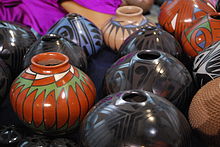Mata Ortiz pottery
Named after the modern town of Mata Ortiz, which is near the archeological site, the style was propagated by Juan Quezada Celado.The success of the pottery, which is sold for its aesthetic rather than its utilitarian value, has brought the town of Mata Ortiz out of poverty, with most of its population earning income from the industry, directly or indirectly.[4] One critical element to the development of ceramics in Mata Ortiz is its proximity to the Paquimé or Casa Grandes archeological site.[3] Since then, the Museo de las Culturas del Norte was opened at Paquimé in 1997 and it was declared a UNESCO World Heritage Site in 1998.[9] He found fragments of Paquimé pottery and the even older Mimbres style, characterized by bold black-on-white zoomorphic designs.[3] For example, he found that vessels of pure clay were too brittle and after studying the edges of the broken old pottery, he discovered the use of sand and other coarse material as a temper.[2][9] By the mid 1970s, Mata Ortiz pots by Juan Quezada were selling for several dollars apiece including to traders from El Paso, prompting him to teach the craft to his brothers and sisters.They also created different designs and formed a new hub of pottery making in the El Porvenir neighborhood which then produced various other potters of various skill levels.[8] Quezada's departure from original ancient styles and with a large number of people now working on the pottery, further innovations have occurred.The first to do large scale promotion of the pottery in the country was amateur anthropologist Spencer MacCallum, who helped get Quezada his first museum showings.He brings pots into the United States to sell, arranges exhibitions and classes and even offers free services as translator and financial advisor.While not the only American to promote the pottery, he has been the most dedicated, publishing a book about it in 1993 called The Miracle of Mata Ortiz and regularly writes and lectures on the subject.An exhibit called “Juan Quezada and the New Tradition” traveled to five venues in the United States and brought unprecedented attention to Mata Ortiz and expanded the market for their wares exponentially.[8] However, this does not fully explain how a rural community has been able to produce a large number of highly skilled artisans in such a short period of time.[3] The 1990s and 2000s has attracted the attention of government handcraft agencies to the town, particularly FONART, which sponsors an annual ceramics competition to help new potters gain recognition.However, they are generally based on Quesada’s single-coil method, using the gray, yellow, orange, red and white clays from the area just as those in Paquimé did.More clay is added as a coil which is pressed into the top edge of the tortilla, then upon itself to form the walls of the vessel as the bowl is turned, which helps keep the shape and thickness even.Some potters stick to geometric patterns and colors very similar to those on original Pakimé pottery with the oval shaped vessel considered “classic” .[4] Newer painted designs include zoomorphic shapes such as lizards, snakes, fish, birds and others, almost always related to the desert environment.






Museum of ManSan DiegoMogollonCasas GrandesChihuahuaMata OrtizJuan Quezada CeladoSpencer MacCallumEl Paso, TexasSierra Madre OccidentalPaquiménorthwest Mexico/southwest U.S. regionMogollon cultureCharles C. Di PesoUNESCO World Heritage SitePuebloArizonaNew Mexicozoomorphiccow dungDeming, New MexicoArizona State MuseumPremio Nacional de Ciencias y ArtesErnesto ZedilloHeard MuseumPhoenixChaffey CollegeMaxwell Museum of AnthropologyFranz Mayer MuseumMexico CityFONARTSandra Day O'ConnorLaura Bushhacksawmanganesepinch potssgraffitoMexican handcrafts and folk artMexican ceramicsCeramics of JaliscoPottery of MetepecSoteno familyBarro negro potteryBlanco family (Oaxaca)Green glazed pottery of AtzompaTalavera potteryTree of LifeAmuzgo textilesBasketry of MexicoHuipilMexican rag dollPetateQuechquemitlRebozoTenango embroideryTextiles of MexicoTextiles of OaxacaCartoneríaLupita dollsMiss Lupita projectPiñataOcotlán de MorelosSan Bartolo CoyotepecSan Martín TilcajeteSan PablitoSanta Clara del CobrePunzo familySanta María AtzompaSanto Tomás JaliezaTemoayaTenancingo, State of MexicoTeotitlán del ValleTlalpujahuaTlaquepaqueTonalá, JaliscoAlfeñique fairCiudadela MarketFeria Maestros del ArteMexico City Alebrije ParadeMuseo de Arte PopularMuseo de la Laca and the Santo Domingo monasteryMuseo de Trajes RegionalesMuseo Estatal de Arte Popular de OaxacaMuseo Nacional de la MáscaraMuseo Regional de la Ceramica, TlaquepaqueMuseo Universitario de Artes Populares María Teresa PomarNational Fund for the Development of Arts and CraftsNational Museum of Mexican ArtNational Pyrotechnic FestivalPalm Sunday Handcraft MarketList of Mexican artisansChiapasGuanajuatoGuerreroHidalgoJaliscoMichoacánOaxacaPueblaState of MexicoTlaxcalaAlebrijeAlfeñique in MexicoHuichol artMexican featherworkMexican handcrafted fireworksMexican ironwood carvingsMexican lacquerwareMexican mask-folk artMexican pointy bootsPiteadoPopotillo artSawdust carpetTraditional copper work in MexicoTraditional metal working in MexicoTraditional Mexican handcrafted toysVocholVotive paintings of MexicoMaría Teresa PomarMarta TurokYouTube